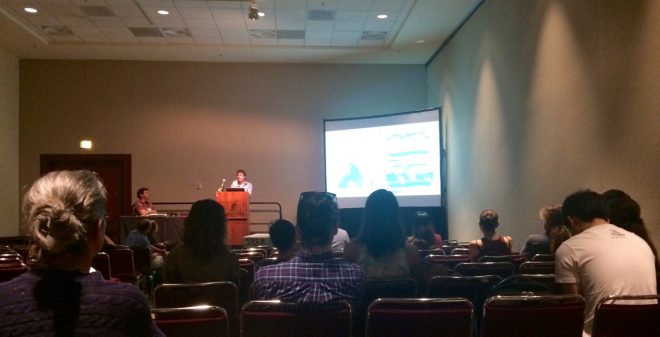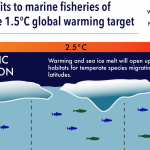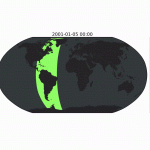Nearly 4000 people attended the Association of the Sciences of Limnology and Oceanography (ASLO) Aquatic Sciences Meeting in Honolulu, Hawaii, from February 27 to March 3, making it the largest conference of the beginning of the year.
Nereus Program Fellow Gabriel Reygondeau (UBC) presented at the conference, the aim of which was to promote an exchange between researchers investigating various aspects of freshwater and marine systems. All fields of ocean science were covered, from freshwater biochemistry to management, from satellite use to DNA and genomics. As well, species at each trophic level, including bacteria, viruses, plankton, fish, and mammals, and all the new models were looked at.
“There was a real emphasis on the ‘omics‘ from techniques to cataloguing of species and DNA,” said Reygondeau. “Next thing we all want to have is collaboration with ecologists to tackle questions between DNA and ecological problems.”

Nereus Fellow Gabriel Reygondeau presents on marine biodiversity at the ASLO 2017 conference.
He also noted that the conference had only one section on climate change and management talks had a clear focus on fresh water resources.
On March 3, Reygondeau delivered a presentation entitled “Current spatial pattern of global and multi-taxonomic marine diversity”. The presentation focused on how thermal regimes can explain latitudinal gradients in of biodiversity in marine ecosystems.
Presentation abstract:
Latitudinal diversity gradients (LDGs), with species richness peaking in the tropics and tailing off towards the poles, form one of global biodiversity’s most remarkable macroecological patterns. LDGs have been detected in the field for many taxa, time periods and regions. In marine systems, recent theories propose that temperature, as well as the interplay between species’ thermal strategies (i.e. thermal optimum and niche breadth) and the thermal regime they are exposed to, explain a significant part of LDGs. Here, we assemble a global multi-taxonomic dataset of 51 million records for 43,175 extant marine species ranging from phytoplankton to marine mammals, to quantify species’ thermal strategy and geographical distribution (i.e. occurrence within a single or multiple biome(s)), as well as identify the main differences in biodiversity patterns among biomes and taxonomic groups. We show that species with narrow thermal breadths display a steep LDG, with highest species richness (SR) in the tropics, whereas groups with wider thermal breadths exhibit highest SR in the temperate realm. We further demonstrate that thermal gradients, species’ thermal strategies and their geographical distribution explain the LDG patterns of many taxonomic groups. Our results provide a unifying explanation for observed patterns of contemporary global marine biodiversity that are complementary to other LDG hypotheses. The predictable linkages of LDG to thermal strategy and ocean temperature underscore the potential large impacts of ocean warming on marine biodiversity.








